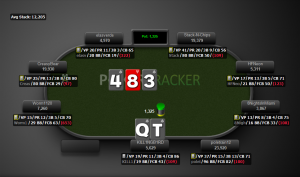One of the most common topics that often comes up early in my discussions with new students – sometimes even in initial conversations before they actually become students – is continuation betting. People want to know how often they should be c-betting, which boards are good for c-betting, what the ‘right’ c-betting percentage is, and more. Almost everyone tends to assume they’re not getting it right when it comes to this aspect of their game. The funny thing is, this is mostly true – but not in the way they think.
The ‘aggression is always good’ assumption
In the early days of online poker, there was one principle to rule them all – aggression. The assumption was that aggression was universally good, and that the most aggressive player in any given situation would usually win. Between 2008 and 2012 several high-profile players came along with reputations for being more aggressive than anyone who had come before, and all of a sudden every low-stakes MTT player on the planet was doing their best to 3-bet bluff as much as possible.
More recently, however, three specific letters have come along that changed everything – G-T-O. The arrival of GTO (Game-Theoretically Optimal) poker as a major source of theoretical discussion over the last few years has shifted our perspective as poker players and learners – even those of us who may not have reached the point of incorporating game theory ideas into our thought process are now broadly familiar with the idea that going hell-for-leather from the start of the tournament isn’t usually a great idea. To quote Phil Galfond, “you don’t make money in poker by making people fold” – thanks to GTO concepts and calculators, we can now test and prove this theory.
 Picking the wrong boards and lacking balance
Picking the wrong boards and lacking balance
One important thing that GTO calculators have done for poker theory is to allow us to study in great depth the dynamics at work when two players go to a flop heads-up. We can prove that when the flop is particularly good for the preflop raiser, the raiser should usually c-bet more often, and when it’s less good for them, they should c-bet less often. However, many people are either unaware of these realities, or implement them very poorly, and they end up giving up a lot of chips both in situations where they do c-bet, and especially in the instances when they don’t.
On strong, static flops (Ace-high or King-high, few draws) people rightly c-bet very often, and while their checking ranges are usually condensed to the point of mostly containing middle-strength value hands, they get away with it thanks to weaker opponents and the lower frequencies with which these checking situations actually occur.
On more dynamic boards (Jack-high or lower, lots of draws), however, people suddenly start doing things a little differently. People know that these boards hit their opponents’ ranges more frequently, so they don’t c-bet bluff as often, but they also never fail to value-bet their stronger hands, because they’re afraid of being drawn out on, or of making tough decisions on future streets.
The result of this is that their c-betting range is heavily weighted towards value with perhaps a few strong draws used to bluff, and their checking range contains absolutely no strong hands! When they’re checking as much as 50% of the time or more on these flops, it doesn’t take much to see how easy it is for these players to tie their own hands on these boards and be exploited, sometimes even by accident on the part of weak players who ‘click buttons’ and end up making profitable decisions.
Range protection and slowplaying
The crux of the above problem lies mostly in the fact that players tend to have very vulnerable checking ranges when they’re using this c-betting strategy, particularly out of position, so the answer lies in adapting those ranges to allow ourselves to play more profitably on the turn and river, where the pots get bigger.
In the latter case, where we’re looking at a dynamic board that isn’t particularly good for our range as the preflop raiser, we need to begin adding value hands into our checking range in order to protect it against our opponent’s aggression, and backing ourselves to make good decisions on future streets, even if bad cards come.
In the former case, protecting our checking range is a little more difficult without reducing our overall c-betting frequency, but it can be done. It’s a case of picking our checking hands more carefully, and slowplaying just those few combos that have blockers to the most common parts of our opponent’s value range. Checking top set on an Ace-high board, for example, makes a lot of sense, but checking bottom set may lose value from the many top pairs in villain’s range.
In the cases where we do slowplay a strong hand, our range benefits massively from the protection that we give it by doing this. We’re no longer as vulnerable to frequent turn and river barrels from our opponents, and we can begin catching bluffs in spots where we would never otherwise be able to do so. By decreasing our c-betting frequency just a little, we improve our turn and river play exponentially.
Implementing this change in your game
It might be a little rough making this change to your game at first, but stay patient. You might think that reducing your c-betting frequency is a matter of bluffing less often, and it might seem strange that I’m advising that, but it’s actually the other way around.
It’s a matter of maintaining reasonable bluffing frequencies while reducing your inclination to auto-bet for value, and learning to slow down with most of your range on dynamic boards. There will be tough decisions ahead, but that’s the case with all of poker, so considering the big picture will work out in the long run.


